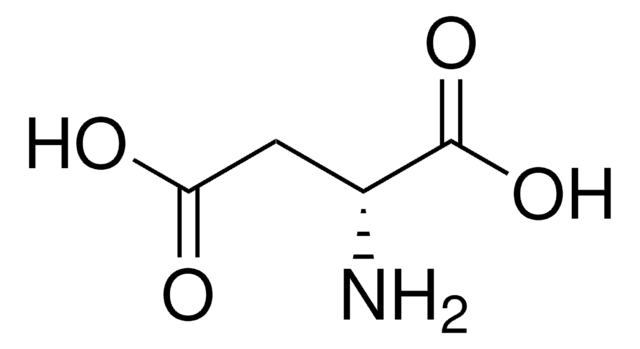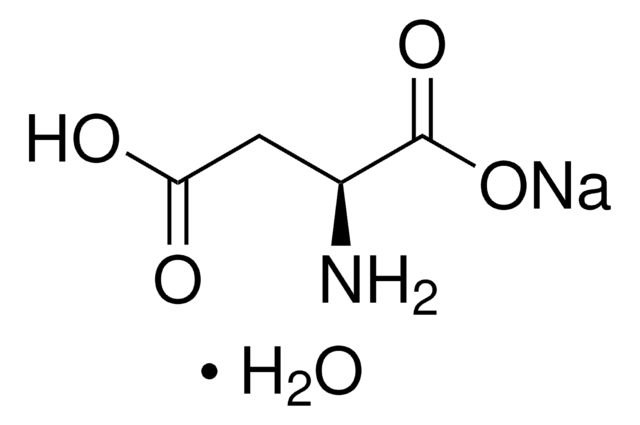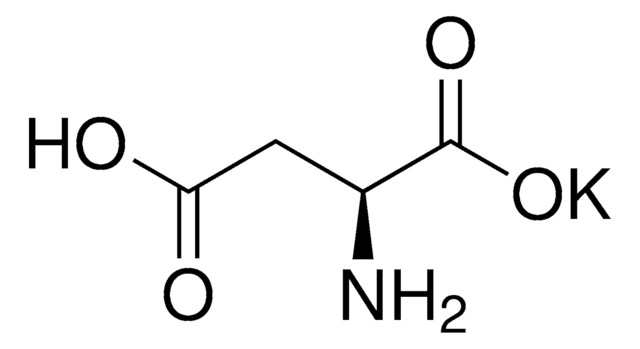A8949
L-Aspartic acid
BioXtra, ≥99% (HPLC)
Sinonimo/i:
(S)-(+)-Aminosuccinic acid, (S)-Aminobutanedioic acid
About This Item
Prodotti consigliati
Nome Commerciale
BioXtra
Livello qualitativo
Saggio
≥99% (HPLC)
Stato
powder
Impurezze
≤0.0005% Phosphorus (P)
≤0.1% Insoluble matter
Residuo alla calcinazione
≤0.1%
Colore
white to off-white
Punto di fusione
>300 °C (dec.) (lit.)
Solubilità
1 M HCl: 0.5 M, clear, colorless
Anioni in tracce
chloride (Cl-): ≤0.05%
sulfate (SO42-): ≤0.05%
Cationi in tracce
Al: ≤0.0005%
Ca: ≤0.001%
Cu: ≤0.0005%
Fe: ≤0.0005%
K: ≤0.005%
Mg: ≤0.0005%
NH4+: ≤0.05%
Na: ≤0.005%
Pb: ≤0.001%
Zn: ≤0.0005%
Stringa SMILE
N[C@@H](CC(O)=O)C(O)=O
InChI
1S/C4H7NO4/c5-2(4(8)9)1-3(6)7/h2H,1,5H2,(H,6,7)(H,8,9)/t2-/m0/s1
CKLJMWTZIZZHCS-REOHCLBHSA-N
Informazioni sul gene
human ... CA1(759) , CA2(760)
rat ... Grin2a(24409)
Cerchi prodotti simili? Visita Guida al confronto tra prodotti
Categorie correlate
Applicazioni
- Metabolomics Analysis Identifies Differential Metabolites as Biomarkers for Acute Myocardial Infarction.: Research identifies key metabolites, including L-Aspartic acid, involved in the metabolic pathways affected during acute myocardial infarction. This study enhances the understanding of biochemical changes during heart attacks, potentially leading to better diagnostic markers (Zhou et al., 2024).
Azioni biochim/fisiol
Applicazioni
Codice della classe di stoccaggio
11 - Combustible Solids
Classe di pericolosità dell'acqua (WGK)
WGK 1
Punto d’infiammabilità (°F)
Not applicable
Punto d’infiammabilità (°C)
Not applicable
Dispositivi di protezione individuale
dust mask type N95 (US), Eyeshields, Gloves
Scegli una delle versioni più recenti:
Possiedi già questo prodotto?
I documenti relativi ai prodotti acquistati recentemente sono disponibili nell’Archivio dei documenti.
I clienti hanno visto anche
Chromatograms
application for HPLCapplication for HPLCIl team dei nostri ricercatori vanta grande esperienza in tutte le aree della ricerca quali Life Science, scienza dei materiali, sintesi chimica, cromatografia, discipline analitiche, ecc..
Contatta l'Assistenza Tecnica.





